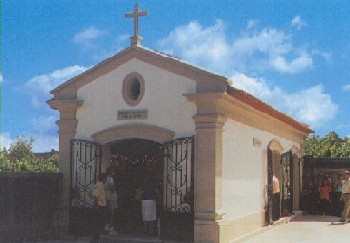SANTUARIO DE SAN CAMPIO
DE LONXE

Ubicado en la Provincia de Pontevedra, Ayuntamiento de Tomiño, carretera C 550, Km. 190,5 dirección Tui-A Guarda.
SAN CAMPIO , soldado romano, padece el martirio en los tiempos de los emperadores Diocleciano y Maximiliano, año 306, y es sepultado su santo cuerpo, por sus compañeros en la fe, en el cementerio de Sano Calixto - Catacumbas- en Roma.
Por su ejemplo y firmeza en confesar su fe en Cristo, siguen en el camino del martirio su mujer Arquelaida y los tres hijos de corta edad.
El comienzo de la devoción a SAN CAMPIO "de Lonxe", en Figueiró, se pierde en la lejanía de los siglos.
El suntuoso Santuario donde hoy se venera, data del año 1804, y fue construido sobre una antigua capilla en la honra de San Antonio de Padua. Fue reedificado en los años 1871-1874. Se consolidó en 1974 y se reformó en el año 1993.
Acuden diariamente romeros que llegan de los lugares mas recónditos de Galicia y de la parte Norte de Portugal.
El nombre que recibe de SAN CAMPIO "de lonxe" se debe a que los romeros vienen a pie desde muchos kilómetros de distancia, y queda lejos el Santuario, en relación la otros lugares donde veneran este Santo.

También se conoce como SAN CAMPIO "del monte" por el peregrinar de los romeros por montes o matorrales buscando atajos para llegar primero a los pies del Santo.
Se le invoca para toda clase de enfermedades, especialmente en las de cáncer, reumáticas y nerviosas o mentales. En tiempos pasados fue "el gran médico venturoso" lo que se recurría para curar todo "mal de la cabeza" y también los que sufrían de "ramo cautivo", es decir, posesión diabólica.
Conforme había sido la enfermedad en la que el Santo mostró su intercesión -o para la que esperan alcanzar- serán los exvotos que se le ofrecen. De esto viene que cientos de figuras de cera, representando manos, pies, cabezas, gargantas, estómagos, pechos, cuerpos enteros, etc., sean depositados en su altar.
También eran frecuentes las promesas de pesarse a trigo, centeno o sal. El ofrendante paga su peso en la especie indicada o su imponerte en metálico. Para cumplir este voto hay una pesa muy antigua o balanza colgante, a modo de báscula romana, donde en un platillo se colocaba el romero y en el otro la materia de la ofrenda.

Por haber sido soldado se le tiene como patrón o protector tutelar de los jóvenes que sirven a la Patria. Antes de ir el servicio peregrinan a San Campio buscando su protección y muchos -como símbolo- le ofrecen la corbata, y al regresar vienen a darle gracias, y si obtuvieron alguna medalla o triunfo en las campañas también se la ofrecían, rindiendo este homenaje a su Capitán.
EL CACHE
EL CONTENEDOR ES UN BOTE DE ROSCA MAGNÉTICODE TAMAÑO PEQUEÑO, QUE CONTIENE DE INICIO LO SIGUIENTE:
LOGBOOK + CERTIFICADO FTF
LAPIZ + SACAPUNTAS
VARIOS JUGUETES
El cache esta escondido en una zona de mucho tránsito ser cuidadosos, y recordar que estais en un santuario respetad la zona.
SANCTUARY OF SAN CAMPIO
DE LONXE
Located in the province of Pontevedra, City of Tomiño, road C 550, Km 190.5 address Tui-A Guarda.
SAN Campio, Roman soldier, suffered martyrdom in the times of the emperors Diocletian and Maximilian, 306 AD, and buried his holy body, by their fellow believers in Callisto Sano Cemetery - Catacombs-Rome.
By their example and firmly confessed their faith in Christ, continue on the path of martyrdom Arqueles his wife and three young children.
The beginning of the devotion to San Campio "of Lonxe", in Figueira, is lost in the distance of centuries.
The sumptuous sanctuary where they worship today, dates from 1804, and was built on a former chapel in honor of San Antonio de Padua. It was rebuilt in the years 1871-1874. Was consolidated in 1974 and was renovated in 1993.
Pilgrims come daily arriving from the hidden places in Galicia and the northern part of Portugal.
The name given to SAN CAMPIO"of lonxe" is that the pilgrims come by foot from many miles away, and is far from the sanctuary, on the other places to venerate the saint.
Also known as SAN CAMPIO "the mountain" for the journey of the pilgrims through woods and bushes looking for shortcuts to arrive first at the feet of the saint.
Is invoked for all sorts of diseases, especially in cancer, rheumatic and nervous or mental. In times past was "the great physician fortunate" that was resorted to cure all "sick in the head" and also suffering from "branch captive", ie, demonic possession.
As had been the condition in which the saint expressed his intercession, or to-be hoping to reach the ex-votos offered. From this comes as hundreds of wax figures, representing the hands, feet, heads, throats, stomachs, breasts, whole bodies, etc., Are deposited in the altar.
They were also weighed frequent promises to wheat, rye or salt. The giver pays its weight in the specified species or the upper hand in cash. To fulfill this vow is a very old or balance weighs pendant, as a Roman scale, which was placed in a saucer of rosemary and the other the subject of the offering.
Having been a soldier, he is patron or tutelary protector of young people who serve the country. Before going on a pilgrimage to San Campio service seeking their protection and many-as-symbol offer tie, and come back to thank him, and if you got a medal or win in the campaigns also offered, paying this tribute to his captain.
THE CACHE
THE CONTAINER IS A POT OF SMALL MAGNETIC THREAD, YOU HOME CONTAINS THE FOLLOWING:
FTF CERTIFICATION + LOGBOOK
PENCIL + SHARPENER
OTHER TOYS
The cache is hidden in a high traffic area to be careful, and remember that you are in a sanctuary Respect the area.
